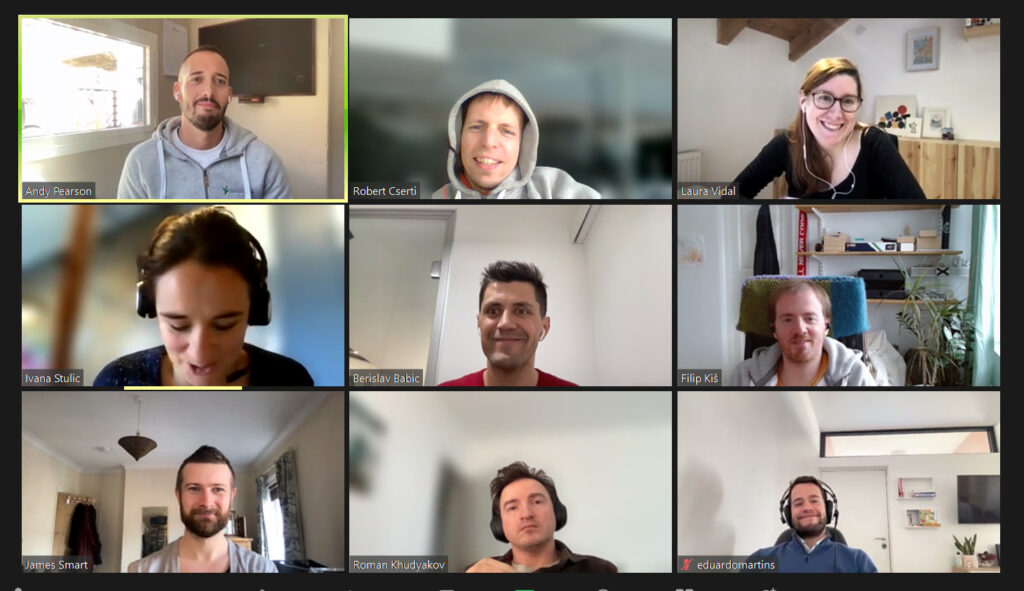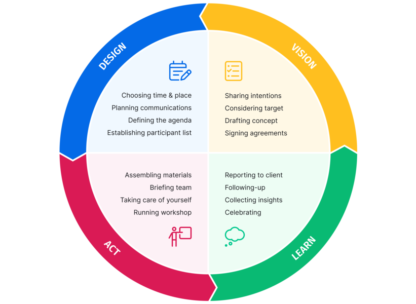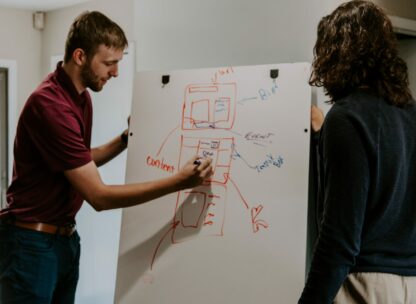How we ran our team retreat online (2022)

We are a fully remote team at SessionLab, since day zero, embracing asynchronous remote collaboration.
Periodically, it’s important to align though. Both in a strategic sense, so we altogether row in the same direction. And also to keep up and improve team cohesion.
As a distributed team, with entirely flexible working hours, it’s hard to find time and opportunity for moments that build bonds among team members.
Therefore, live meetings have always been among the most anticipated events. Our team meeting at the Croatian seaside in 2021 August was a major boost to our team spirit.
We tend to do such full-team events twice a year, and prior to summer of 2021, we had to go for a year and a half without it. That was challenging for our culture and team cohesion, thus the human connections we can build by spending three days together are essential.
For a set of practical reasons, we used to have our other team retreat in late January / early February. It’s a good time to be back together after the winter holiday season, and also the perfect timing to set our annual goals and align for the next quarter(s).
So everybody was really looking forward to the prospect of seeing each other face to face. But the omicron wave of covid disrupted our plans and eliminated any reasonable hope for the first couple of months of 2022 to bring people together for a week from 8 different countries.
So we had to move our team retreat online.
Design considerations of an online retreat
We had two primary goals to work on:
- Strategy & planning: Get us aligned on our strategy, set goals for the year and align our plan for the upcoming quarter
- Team: Make sure we all feel more connected to each other, and replenish our Trust Batteries for the upcoming months.
The goals above set two distinct streams of activities for our retreat. Next to these we also had a few generic design considerations:
Scatter over a week so as not to overwhelm
From the goals above, we knew it would roughly take 2.5-3 days of sessions to achieve them.
Given that (i) we already work online the full day (ii) we do have ongoing business with customers to support (iii) since we all work remote and have our own everyday schedule constraints (iv) although the team is based throughout Europe, we still had a 3 hour time difference between some team members to take into consideration.
We decided it’s best to spread our planned activities over a week, generally aiming to schedule fixed sessions for the middle of the day, so everyone can manage their personal agenda.
This led to a ~50% time commitment over a week, a bit more breathing and reflection time between strategy sessions, as well as everyone still being able to do most of the business-as-usual type of activities.
Alternate between more serious ‘strategy’ sessions and ‘lighter’ team focused sessions
To maintain a good level of focus throughout the week, we wanted to have a mix of activities, and sprinkle in some of the team-focused activities that are generally lighter.
It also results in a better flow, if you get people actively interacting with each other right away in the first days of the online retreat. The better team cohesion you have, the better your strategy discussions will go.
End the week with some light-hearted fun event
Many of the sessions we planned had some element of seriousness – i.e. strategy setting, or workshopping on team culture. By the end of the week, after 15-20 hours of online meetings, people just appreciate some fun to switch off and start their weekend.
Strategy & planning
This annual meeting intentionally coincides with the time when we set our annual goals.
So it’s also part of a bigger process, where the expected end result is that we are all aligned together as a team on what we DO and what we DON’T DO in the upcoming year and more specifically in the upcoming quarter.
Prequel: Annual strategy planning – Leadership Retreat
Before we started our online team retreat, the first step was to ensure that we arrive at the team retreat with clear Company level goals for the year, i.e. the 3-6 main things we want to achieve, and the main priorities for the first quarter of the year.
This was a separate 2-day retreat for our Leadership Team, strictly following the process and recipe of the Entrepreneurial Operating System (EOS), that we recently started implementing to help our company scale effectively.
Entrepreneurial Operating System (EOS) – and why we are implementing it
Since we last attempted an annual planning session alongside a team retreat last year, our team has grown.
One of themes for us in the past year was facing the typical growing pains when a business turns from a primarily founder-driven organization to a bigger team, where the key to success is empowering our team members and building out the right processes for each area of our business.
It was no longer about what I – as a co-founder – can get done to move SessionLab forward, but how to delegate better, and enable our team members to own their respective parts of the business. (I loved being a “doer” for years, and it was certainly a challenge to accept that I have to measure myself not through my own output, but on how well I lead and enable people in the organization)
One of the organizational frameworks that I’ve heard too many times to ignore in the self-funded B2B SaaS world (big credits especially to two podcasts: Seeking Scale and Startups for the Rest of Us) recently was the Entrepreneurial Operating System, aka EOS, which is a framework for to help business scale.
Why EOS?
There are many business frameworks on goal setting and management. So why did we chose the Entrepreneurial Operating System specifically Briefly:
- This was a sufficiently comprehensive and prescriptive toolkit: it not only tells us how to set goals, but also gives the exact recipes on how to set up an accountability (org) chart, company scorecards, specific meeting cadence with meeting structures, document processes, etc.
- Several fellow B2B SaaS company founders who I trust had recommended the EOS framework.
And one of the best and unanimous pieces of advice I heard from fellow founders in similar shoes is just “adopt it by the book” – whichever framework you choose, instead of trying to reinvent the wheel in the past, which we often did.
So we followed the EOS recipe for a two-day annual strategy alignment workshop with our leadership team.
This was an exciting process, to help us align both on our long term vision of the company, as well as getting clarity on the most important priorities for the upcoming year – which will be detailed in an upcoming separate blog post and session template.
From the perspective of our team retreat, this strategy workshop gave the necessary vision and foundation to present our strategy and goals to our full team, and then enable everyone to contribute in their own areas to the annual goals.
So now back for the actual week of our team retreat:
Year Review and Present Annual Plans
As we started the team retreat, we kicked off with a session to bring our team on the same page regarding the results of last year and the plans for the year ahead.
We had several new members joining our team during the past year, so we started with a quick recap of what we did over the past year, followed by an interactive quiz to present main business KPIs.
We wanted everyone to understand the key trends on what drives our business, so apart from having a fun competition on who made the best guesses about our key KPIs, we also made sure to have a dialog about some of the more interesting trends we observed.
Since this annual goal setting process was also the official “debut” of EOS in our company, we allocated some time to review our Company Vision, Purpose and related items as per the EOS framework, including exciting things such as: Where do we see our company in 10-years, our Marketing Strategy, and how our company’s operations will look like in 3 years. (This all fell under the V/TO Presentation – denoting “Vision/Traction Organizer” in the agenda shown above.)
As we have been quite a product focused company so far, we also included a discussion centered around Product Strategy, where we used the 1-2-4-All method to generate ideas for some of the product challenges we want to focus on during the upcoming year. This was a much appreciated cross-functional discussion in the team.
1-2-4-All #idea generation #liberating structures #issue analysis
With this facilitation technique you can immediately include everyone regardless of how large the group is. You can generate better ideas and more of them faster than ever before. You can tap the know-how and imagination that is distributed widely in places not known in advance.
Open, generative conversation unfolds. Ideas and solutions are sifted in rapid fashion. Most importantly, participants own the ideas, so follow-up and implementation is simplified. No buy-in strategies needed! Simple and elegant!
The meeting then was wrapped up by presenting the two key takeaways from the previous week’s Strategy Retreat:
- Our annual company goals
- Priorities (a.k.a. Rocks as per EOS) for the upcoming quarter.
The important aspect here was to connect these company level priorities to each department of the company, because teams were going to elaborate on these plans for their respective Q1 planning sessions in the coming days.
Team specific planning sessions
We scheduled 4 separate planning sessions on Day 3 and Day 4, one per each “department” of the company: Product, Marketing, Customer Growth, Operations.
While some of these departments are 1-2 people teams currently, it is still important that everyone gets a sense of ownership of the company goals, and breaks those down to more specific goals and measurable targets for their own work.
These were relatively straightforward, 1-2 hours length sessions for each team, facilitated by myself, as I’m wearing the Integrator hat of EOS. They followed the same process:
Everyone lists what they think has to be done in the coming quarter, and then presents their ideas. Typically we end up between 10 and 40 virtual post-it notes in Mural. Then the team discusses each point, and merges or removes items, until we arrive at a manageable number of Rocks (Priorities) for the department.
We made sure the meaning and potential subtasks under the Rocks are captured, and assigned a clear owner assigned for each Rock. For many of the Rocks, it is quite straightforward who owns them – often either based on role, or who was the most vocal in pushing that to the agenda.
The amazing thing is that we ended up with a manageable set of main priorities for each department, and everybody in the company had become a clear owner of at least one Rock to ensure ownership and accountability. Hurray for delegation and sharing responsibilities!
Present back Rocks (Priorities) to the company
The last session in our strategy stream was a short presentation of sharing the Department Rocks in an all-team setting. This was so members of our Marketing and Customer Success teams could learn about product priorities, and vice versa.
As per the philosophy of owning one’s Rocks, everyone presented their own Rocks that had been neatly inputted into our company handbook in our company handbook in Notion.
The schedule above shows how we spread the events during the week: red shows the strategy stream of sessions (where Wednesday/Thursday each team member had one of the team-specific planning sessions), and the green indicates the team cohesion and team building focused events.
Working on team culture and cohesion
Missing the opportunity to meet in live meant even more emphasis on setting the right type of events to create meaningful and memorable interactions between our team members.
How did we decide what to do here?
We had an ongoing culture definition process that we started at our Summer Meeting. We took up the Culture Design Canvas as a framework to guide our thinking.
Culture Design Canvas #culture #culture change #purpose #team alignment #remote-friendly
The Culture Design Canvas is a framework for designing the culture of organizations and teams. You can use it to map the current culture, design the future state, and evolve your company culture.
By this point, we already clarified our Values and Purpose, and had a prior workshop where we were aligned on Psychological Safety and Behaviors we reward in our team.
We had a next segment, centered around the important topics of Feedback and Rituals. This was a clear candidate for a workshop, where we continued working with our amazing external facilitator, Ivana Stulic.
So this was a clear cut candidate for a dedicated team workshop
Next to this, we made two more slots in our week for two other organised team events:
- One with the purpose of team cohesion – something that is more of thoughtful but fun activity that gets us to learn more about each other
- One just for the sake of having something fun and interesting activity to do together.
Team cohesion
One of the hard things about moving a team retreat from in-person to an online environment is that we lose all that social time we have outside of working sessions when we spend 2-3 days at the same venue. At in-person retreats, there are lots of small conversations happening organically, in which we learn more about each other which makes us feel more connected. So we wanted to have an activity that can at least partially bring this aspect of meaningful social connection.
Cozy Juicy Real is an amazingly well designed online activity, which facilitates such conversations to happen in a structured way. In essence, it’s a board game type of group interaction, in which we all get to answer a series of either funny or thoughtful questions about ourselves, allowing us to open up as we play the game. One minute you are laughing hard, and a minute later you discover deep truths about your colleagues.
Being a group of eight people, it still allowed us to play in one group (beyond that group size, it’s better to split up into multiple groups) – this was the best spent and most appreciated two hours during our team retreat.
Fun team event
Here the concept was simple: let’s pick an activity where we do something together.
We asked our team members to chip in with some ideas, polled our team on one of our all-hands meetings which one they wanted most, and we ended up booking an Airbnb experience on learning magic tricks. (Slightly winning over preparing homemade pasta with the virtual guidance of a real Italian grandma.)
We also booked time after the wizard event to have a bit of casual conversation and hangout to close the day.
A happy hour with some drinks can be a nice alternative – something we could easily do in live, but gets more tricky with organizing the right time for it online. (Having a drink in the early afternoon before you pick up your kid from kindergarten was just not fitting for many of our schedules)
Recap
One important thing is to make sure to collect timely feedback from people on how they perceived the whole experience of the team retreat as well as the individual sessions.
Overall, this spread-out-over-a-week concept was widely welcomed, and most of us appreciated having a couple of working hours left each day to get done those bits of work that are time-sensitive.
The combination of more work-oriented strategy sessions intertwined with team and culture sessions gave a good balance. People particularly appreciated that they had a bit of reflection time between the first day following presentation of annual goals, and their own department’s goal setting session.
And the Cozy Juicy Real game was an absolute success – by far the most valued online team event we had so far.
What we would probably improve next time is to have one of the key team events earlier during the week: Although we had a Team Culture Workshop on Day 2, it was still on the more serious side, so we actually had to wait until Day 4 to have a really meaningful team event. Having such at the beginning could be good as an early morale booster.
I think we have been overall happy with the online retreat in this format – as of, we made the best of what we could.
Nonetheless, it’s really hard to replicate the serendipity and random conversations of a live meeting. If I think back to our summer meeting half a year ago, the first few things that come to my mind and bring a smile to my face are all the unplanned small activities we did in person – and replicating these is a hard challenge.
So we’re still very much looking forward to our next live team meeting!



Leave a Comment